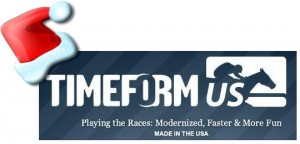Mar 20
2015

Beholder and Gary Stevens. Photo by Alicia Hamm
Continuing on the theme of a prior article on “Visual Handicapping” we’re going to get into more details on questions raised there. Click here to review the visual handicapping article, and learn more about the differences between visual handicapping and trip handicapping.
With visual handicapping, it’s always important to look beyond the raw numbers (i.e. Beyer Speed Figures, Pace Figures, Running Lines) in the Daily Racing Form and ask the question, “How did they do it?”
We raised some of these questions before, but we’ll ask them again:
Read More >>
Feb 27
2015
In the introductory article on the topic of Form, we explained the challenges and potential rewards for mastering the art of evaluating a horse’s current racing Form (aka Fitness, Condition, Sharpness, Readiness). Click here for a review of that article. Unlike Distance and Class, there is no singular column of data in the Racing Form or Program that identifies “Form.” But, possibly the most useful column is the Race Date column. Read More >>
Feb 1
2015
Continuing with the example from a prior article, “There’s Gold In Them Thar Result Charts,” we are going to review the additional information that can be gleaned from these detailed charts. Click here for a review of that article. We looked at a standard result chart and the “Next Race” version that shows you the very next race for all of the horses following the race chart being viewed. That allows you to see exactly how well each horse did after the race. But, how were they doing before, or leading up to the race being reviewed? For that, there is an option to view the “Beyer Figures” (Click here to learn about the fundamentals of Beyer Figures) for up to ten preceding races. The following result chart view was generated from the same July 19 race as in the prior article: Read More >>
Jan 26
2015
In a prior article we described the standard information available to a handicapper through result charts. And, how these once coveted pieces of paper are now available to everyone at the click of a mouse. Well, almost everyone. If you are using the printed copy of the Daily Racing Form, a racing program at the track, or any service that simply prints out the Past Performances (PPs) for each horse in an upcoming race, then you probably don’t have access to the Result Charts. Click here to read the prior article on the standard result charts available through DRF Formulator. In this article (and another to follow) we will describe the many great things above and beyond the standard result chart that are available though the Formulator software. Read More >>
Dec 16
2014

Back in August we introduced readers to TimeformUS with the article, “There’s A New Racing Form In Town.” Since that time we followed up with articles explaining their Trainer Ratings, Speed Figures, and Perspective Comments.
Over the course of the past few months we have been using TimeformUS on a regular basis, enough so that we now feel compelled to submit our Christmas Wish List to TimeformUS. However, unlike other requests this time of year, we’re not looking for our wishes to be fulfilled by December 25. If your little programming elves can see their way to making these enhancements during the coming year, we’d be very happy little horseplayers.
Read More >>
Dec 10
2014
A frequent question asked by new fans trying to learn more about horse racing is, “Where do I begin?” My immediate response is generally, “Get to know your trainers.” While learning about topics like distance, class, and pace are important … in my opinion, none are as important as learning about the tendencies, strengths, and weaknesses of trainers. With that thought in mind, we continue our series of articles called “Know Your Trainers.”
In this series we will dig into the statistics of some head trainers and try to make sense of the numbers we find. We thought it might be fun to present the numbers in a “competitive” manner by pairing trainers. With that said, we are not trying to judge the trainers or claim that one is better than another. Our intention is to pair trainers who have statistics in comparable categories and present some plausible reasons why they might differ.
The two trainers in this article, Peter Miller and John Sadler, both work on the Southern California racing circuit.
Read More >>
Dec 4
2014
In the introductory article on Racing Form, we listed a subtopic called “Racing Into Form.” Click here for a review of the introduction on Form. Nearly every trainer at one time or another has been called into the racing secretary’s office and asked the following question: “We need to fill the fifth race on Sunday. Can you do me a favor and enter your horse in there?” The trainer knows that favors are a 2-way street when it comes to dealing with the racing secretary. So, more times than not, he/she obliges (presuming of course that his horse is sound).
However, being sound does not necessarily mean that his horse is perfectly fit. His verbal reply to the racing secretary might be, “Yea, sure … glad to help you out.” While he’s thinking to himself, I was hoping to get a couple more workouts into him before his next race, but if he wants me to enter my horse on Sunday and work him out in public … so be it.
Read More >>
Nov 23
2014
A frequent question asked by new fans trying to learn more about horse racing is, “Where do I begin?” My immediate response is generally, “Get to know your trainers.” While learning about topics like distance, class, and pace are important … in my opinion, none are as important as learning about the tendencies, strengths, and weaknesses of trainers. With that thought in mind, we continue our series of articles called “Know Your Trainers.”
In this series we will dig into the statistics of some head trainers and try to make sense of the numbers we find. We thought it might be fun to present the numbers in a “competitive” manner by pairing trainers. With that said, we are not trying to judge the trainers or claim that one is better than another. Our intention is to pair trainers who have statistics in comparable categories and present some plausible reasons why they might differ.
In our recent reader survey we received several requests to see trainer comparisons on young trainers. We decided to pick two that we know well and have interviewed in the past. The two trainers are on different racing circuits. Tom Morley trains in New York, while Ben Colebrook prepares his charges in Kentucky.
Read More >>
Nov 14
2014

Being mostly an East Coast horseplayer, I rarely give much thought to racing venues west of Kentucky. For the majority of the year there is plenty to keep me busy without having to “go west young man.” But, with the introduction of a Fall Meet at Del Mar, and me pining for the warmth and sunshine that left Saratoga with the horses, I decided it was time to dip my toes in the racing sands of southern California.

John Lies
But before making any serious wagers, I decided to get some help from a friend that has a birds-eye view of the racing at Del Mar. John Lies is the on-track & simulcast television host that reports live from the paddock at Del Mar each race day. In addition to that, John is the track announcer at Lone Star Park, Will Rogers Downs, and Kentucky Downs. It was the latter track where I first got to know John and wrote a recent article about Kentucky Downs and described John’s “natural teaching qualities.” In addition to that, in 2013 we did a full interview with John.
In a recent conversation with John, I asked him for some tips for horseplayers unfamiliar with Del Mar. The following Question and Answer dialogue took place, and I’d like to share it with you.
Read More >>
Nov 10
2014
A frequent question asked by new fans trying to learn more about horse racing is, “Where do I begin?” My immediate response is generally, “Get to know your trainers.” While learning about topics like distance, class, and pace are important … in my opinion, none are as important as learning about the tendencies, strengths, and weaknesses of trainers. With that thought in mind, we continue our series of articles called “Know Your Trainers.”
In this series we will dig into the statistics of some head trainers and try to make sense of the numbers we find. We thought it might be fun to present the numbers in a “competitive” manner by pairing trainers. With that said, we are not trying to judge the trainers or claim that one is better than another. Our intention is to pair trainers who have statistics in comparable categories and present some plausible reasons why they might differ.
So let’s continue with two of the big names in California, Bob Baffert and Jerry Hollendorfer. Our focus will be in these areas; Graded Stakes, First-Time-Starters, Del Mar, and a couple of profitable angles we uncovered along the way.
Read More >>




